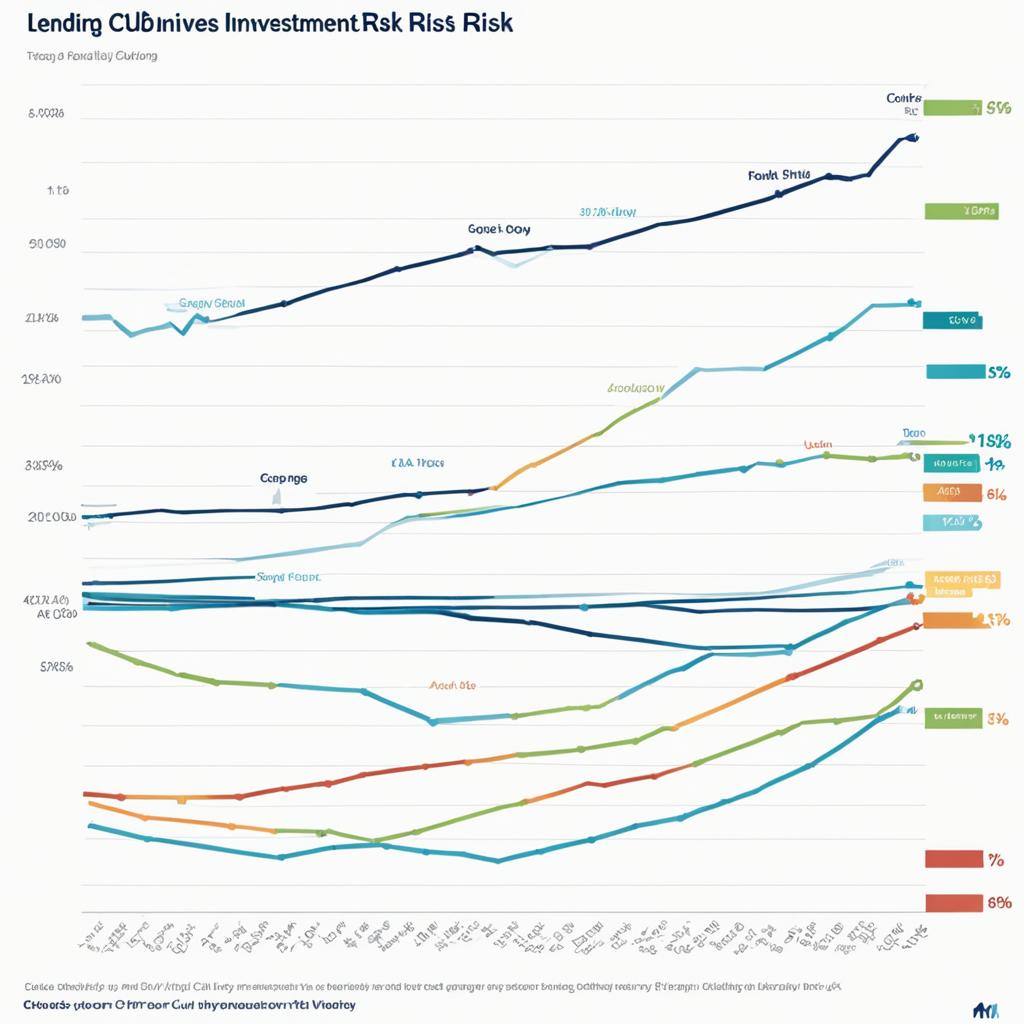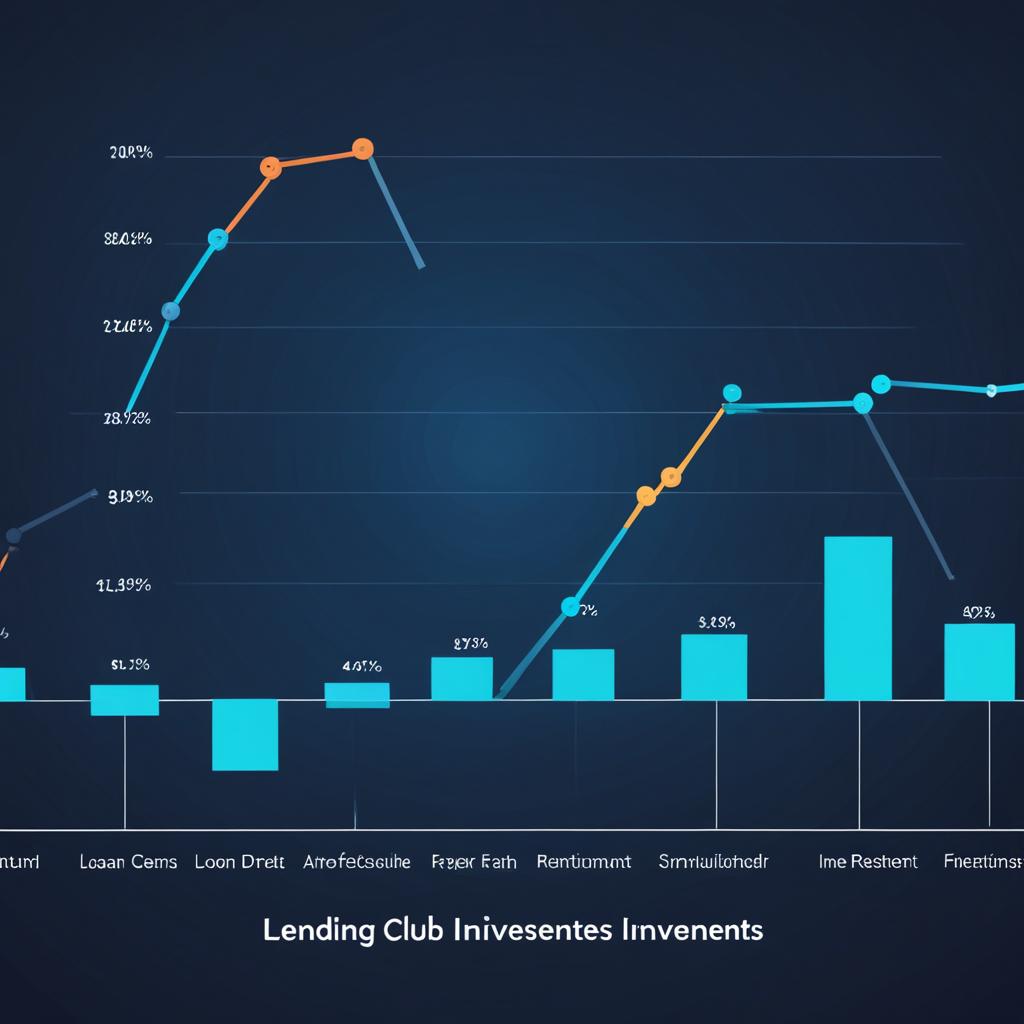Are you looking for investment opportunities that offer attractive returns? Look no further than Lending Club. In this comprehensive review, I will explore Lending Club’s investment platform and provide valuable insights for investors like you.
While Lending Club may no longer offer peer-to-peer lending services, it has transformed into a neo-bank, continuing to provide personal and commercial loans to individuals and businesses. As an investor, you can take advantage of their investment platform to earn interest on your investments.
Whether you’re a seasoned investor or just starting out, Lending Club offers a range of investment options to suit your needs. From automated investing to manual selection, you have the flexibility to choose the approach that aligns with your investment goals and risk tolerance.
However, investing with Lending Club does come with risks, like the possibility of borrower defaults and the lack of liquidity for invested funds. It’s important to weigh these pros and cons and make informed decisions before diving into the world of P2P lending.
So, if you’re ready to explore the potential returns and risks of investing with Lending Club, dive into this review and discover the pathway to maximize your investment portfolio.
Key Takeaways:
- Lending Club offers an investment platform for individuals interested in earning attractive returns.
- The platform allows investors to choose between automated and manual investing options.
- Investing with Lending Club involves risks such as borrower defaults and lack of liquidity.
- Consider diversifying investments and carefully evaluating loan grades and terms.
- Read Lending Club investor reviews to gain valuable insights from others.
Lending Club’s Evolution: From P2P Lending to Neo-Bank
Lending Club, originally known for its peer-to-peer lending services, has undergone a significant transformation and now operates as a neo-bank. Despite discontinuing P2P lending, Lending Club continues to provide personal loans for consumers as well as commercial financing options. In this review, we will focus on the investment opportunities available through Lending Club’s platform.
Lending Club’s journey from P2P lending to a neo-bank reflects the evolving landscape of the financial industry. While the platform no longer facilitates direct lending between individuals, it has expanded its services to offer a range of loan products and financial solutions. This shift enables Lending Club to leverage its expertise in lending and banking to better serve its customers and investors.
“Lending Club’s transition from P2P lending to a neo-bank signifies its commitment to adapt and thrive in a changing market. By diversifying its offerings, Lending Club opens up new possibilities for investors and borrowers alike.”
Under its new model, Lending Club caters to individuals seeking personal loans for various purposes, such as debt consolidation, home improvement, or education expenses. Furthermore, the platform extends its services to businesses in need of financing for expansion, inventory management, or other operational requirements.
The transformation has not only expanded the financial options available to consumers and businesses but also presents unique investment opportunities for individuals looking to grow their portfolios. Through Lending Club’s platform, investors can participate in funding loans and earn returns on their investments.
Investment Offerings at Lending Club
Lending Club’s investment platform enables individuals to invest in loans originated by the company, providing an opportunity to earn interest on their invested capital. The platform offers two investment options:
- Automated Investing: Lending Club offers an automated investing feature that allows individuals to create an investment strategy aligned with their risk tolerance and preferred loan criteria. The platform uses advanced algorithms to allocate investments across a diversified portfolio of loans, offering convenience and scalability to investors.
- Manual Investing: For individuals who prefer a more hands-on approach, Lending Club provides manual investing options. Investors can manually select loans based on borrower profiles, loan grades, and other relevant factors. This approach allows for more control and customization of investment portfolios.
Regardless of the investment method chosen, Lending Club’s investment platform provides investors with the potential to earn attractive returns through interest payments received from borrowers.
A Snapshot of Lending Club’s Investment Platform
Here’s a closer look at the key features and benefits of Lending Club’s investment platform:
| Investment Platform Highlights | |
|---|---|
| Investment Options | Automated Investing and Manual Investing |
| Returns | Potential average returns between 5.06% and 8.74%* |
| Risk Management | Diversification, loan grading system, and historical loan performance data |
| Accessibility | Available to individuals with varying investment experience and capital |
| Liquidity | Investors can access a secondary market to sell their Lending Club notes* |
*Please note that past performance is not indicative of future results. Returns and liquidity may vary.
Lending Club’s evolution from P2P lending to a neo-bank has broadened its reach and enhanced its offerings as a comprehensive financial institution. As we delve further into our review, we will explore the pros and cons of investing with Lending Club, analyze investment returns and risks, and discuss strategies for maximizing profits within the platform.
Exploring Lending Club’s Investment Platform
When it comes to investing, Lending Club offers individuals a unique opportunity to participate in the lending market. Through its investment platform, investors can directly invest in loans originated by Lending Club, allowing them to earn interest on their investment and potentially generate passive income.
One of the key features of Lending Club’s platform is the ability to purchase small portions of loans known as “notes.” These notes represent a fractional ownership of the underlying loan, providing investors with the opportunity to diversify their investments across multiple loans.
Investing with Lending Club is a straightforward process. Investors can choose between automated investing or manual investing. Automated investing utilizes Lending Club’s technology to analyze available loans and allocate funds based on predetermined investment criteria. This option is ideal for investors who prefer a hands-off approach.
On the other hand, manual investing allows investors to handpick individual loans based on their own research and criteria. This option is suitable for investors who prefer more control and involvement in the investment process.
Regardless of the chosen investing method, Lending Club’s investment platform offers transparency through detailed loan information such as loan grade, interest rate, and borrower’s credit history. This allows investors to make informed decisions and assess the risk associated with each loan.
Investing through Lending Club’s platform provides potential advantages. The platform has historically offered attractive returns compared to traditional investments. Additionally, the ability to diversify across multiple loans can help mitigate the risk of individual loan defaults.
However, it’s important to note that investing in loans comes with risks. Borrower defaults can result in a loss of principal, and there is a lack of liquidity as invested funds are tied up for the duration of the loan term.
Key Features of Lending Club’s Investment Platform:
- Opportunity to invest in loans originated by Lending Club.
- Fractional ownership of loans through the purchase of “notes.”
- Automated investing and manual investing options available.
- Detailed loan information for informed investment decisions.
- Potential for attractive returns and the ability to diversify investments.
- Risks include borrower defaults and lack of liquidity.
Investing in loans through Lending Club’s platform can be a rewarding venture, but it’s essential to carefully evaluate the risks involved and have a well-thought-out investment strategy in place.

Exploring Lending Club’s investment platform opens up opportunities to earn passive income by investing in loans originated by the company. The platform provides both automated and manual investing options, allowing investors to customize their investment approach. With the ability to diversify across multiple loans, investors have the potential to earn attractive returns. However, it’s important to acknowledge the risks associated with investing in loans and exercise caution when allocating funds.
Pros and Cons of Investing with Lending Club
Investing with Lending Club can be an attractive option for individuals looking for higher returns compared to traditional investment methods. However, it’s essential to carefully weigh the pros and cons before making investment decisions.
Pros of Investing with Lending Club
- Potential for Higher Returns: Lending Club offers the opportunity to earn attractive returns on investment, with average returns ranging between 5.06% and 8.74%. This can be particularly appealing when compared to low-interest savings accounts or other conservative investment options.
- Diversification: Investing in Lending Club allows for diversification as investors have the flexibility to allocate funds across multiple loans. This diversification can help mitigate the risks associated with individual loan defaults and potentially enhance overall portfolio performance.
- Automated Investing: Lending Club provides an automated investing feature that helps simplify the investment process. This feature allows investors to set specific criteria and preferences, and the platform automatically selects and allocates investments accordingly.
Cons of Investing with Lending Club
- Risk of Borrower Defaults: One of the significant risks associated with investing in Lending Club is the possibility of borrower defaults. As an investor, there is always a chance that borrowers may fail to repay their loans, resulting in a loss or decreased returns on investments.
- Lack of Liquidity: Unlike publicly traded stocks or bonds, investments made through Lending Club lack liquidity. Once invested, funds are tied up until the loans reach maturity, limiting the ability to access the invested capital before the loan terms are fulfilled.
- Potential Economic Impact: External economic factors can impact the performance of loans on the Lending Club platform. Economic downturns or fluctuations in interest rates can affect borrower repayment abilities and, consequently, investment returns.
It’s important to consider these pros and cons while evaluating your investment strategy and goals. Conducting thorough research, diversifying investments, and staying updated on market trends can help mitigate risks and maximize potential returns when investing with Lending Club.

Lending Club Investment Returns and Risks
When considering investing with Lending Club, it’s important to assess both the potential returns and the associated risks that come with the platform. Lending Club claims that investors can earn average returns between 5.06% and 8.74% on their investments, which can be quite appealing compared to traditional investment options.
However, it’s crucial to understand the risks involved in P2P lending, as these investments are not without their uncertainties. One of the main risks is the possibility of borrower defaults. While Lending Club has mechanisms in place to mitigate these risks, it’s still essential to recognize that not all loans will be repaid in full, leading to potential losses.
Furthermore, interest rate fluctuations can impact the overall performance of loans. If interest rates rise, borrowers may struggle to meet their repayment obligations, increasing the likelihood of defaults. Similarly, economic downturns can affect the ability of borrowers to repay their loans, leading to potential decreases in investment returns.
It’s vital for investors to carefully evaluate these factors and their own risk tolerance before deciding to invest with Lending Club. Diversifying investments across various loans and using Lending Club’s automated investing options can help spread the risk and potentially minimize the impact of individual defaults.
“Investing with Lending Club offers the potential for attractive returns, but it’s crucial to remember that these investments come with risks. Conduct thorough research and consider your risk tolerance before making investment decisions.”
Ultimately, each investor should carefully weigh the potential returns against the risks and make informed decisions that align with their financial goals and risk appetite.

Summary of Lending Club Investment Returns and Risks
| Investment Returns | Investment Risks |
|---|---|
|
|
Investment Strategies for Lending Club
When it comes to investing with Lending Club, implementing effective strategies can help optimize your returns and manage risks. Here are some valuable tips to consider:
- Diversify Your Investments: Spreading your funds across multiple loans is crucial to minimize the impact of individual loan defaults. Investing in a diverse range of loans can help distribute risk and enhance the potential for steady returns.
- Evaluate Risk Tolerance: It’s important to assess your risk tolerance before selecting loan grades and terms. If you have a higher risk appetite, you may choose to invest in loans with higher interest rates but also potentially higher default rates. Alternatively, if you prefer more conservative investments, focus on loans with lower interest rates and lower risk profiles.
- Consider Investment Goals: Define your investment goals and align them with the loan grades and terms available on Lending Club’s platform. If your primary objective is capital preservation, you might opt for lower-risk loans with shorter terms. However, if you’re seeking higher returns and can tolerate more risk, longer-term loans with higher potential yields may be suitable.
- Regularly Monitor and Reinvest: Staying actively involved in managing your Lending Club investments is essential. Monitor your portfolio regularly, and reinvest the received payments into new loans to compound your returns. By consistently reinvesting, you can take advantage of the power of compounding and potentially enhance your overall profitability.
- Stay Informed: Keep up to date with market trends and changes in the lending environment. Stay informed about economic indicators, interest rate movements, and industry developments that may impact loan performance. This information can help you make informed investment decisions and adjust your strategies accordingly.
By following these investment strategies, you can optimize your experience with Lending Club’s platform and increase your chances of achieving favorable investment outcomes.
“Diversifying your Lending Club investments across multiple loans can reduce the impact of defaults and enhance your potential for consistent returns.”
Example Lending Club Investment Strategy
| Strategy | Description |
|---|---|
| Blend of Risk and Return | Invest in loans with a mix of loan grades, balancing higher-yield loans with lower-risk options. Diversify across various loan terms and borrower profiles. |
| Conservative Approach | Focus on lower-risk loans with short terms. Prioritize loan grades A and B for more stable returns and lower default rates. |
| Aggressive Growth | Allocate a higher proportion of investments to riskier loan grades such as E, F, or G. Target longer-term loans with potential for higher interest payments. |
| High-Yield, Short-Term | Seek loans with high yields and short-term durations for more immediate returns. Add exposure to higher-risk loans while reducing the time commitment. |

Comparing Lending Club to Other Investment Platforms
While Lending Club no longer offers P2P lending, there are other alternative investment platforms available for investors to consider. These platforms provide unique investment opportunities beyond traditional stocks and bonds. Let’s explore a few popular options:
Fundrise
Fundrise is a real estate crowdfunding platform that allows investors to pool their funds and invest in commercial real estate projects. By investing in a diversified portfolio of properties, individuals can potentially earn regular dividends and benefit from property appreciation. Fundrise offers transparency and accessibility to real estate investments that were previously only available to institutional investors.
YieldStreet
YieldStreet focuses on alternative investments such as litigation finance, real estate, and marine finance. Investors can choose from a variety of asset classes, depending on their risk tolerance and investment preferences. YieldStreet aims to provide attractive returns while minimizing the reliance on traditional market conditions.
Masterworks
Masterworks brings the world of art investing to a broader audience. The platform allows investors to purchase shares in famous artworks, offering a unique opportunity to participate in the art market. With Masterworks, individuals can potentially benefit from the appreciation of artwork values and even earn dividends if the artwork is sold.
These alternative investment platforms offer diversification and potential returns beyond traditional investment avenues. However, it’s essential for investors to compare the features, risks, and potential returns of these platforms before making investment decisions. Each platform has its own set of unique offerings, so individuals should carefully evaluate which aligns best with their investment goals and risk tolerance.
Here is a comparison table highlighting some key features of these alternative investment platforms:
| Platform | Asset Class | Minimum Investment | Potential Returns |
|---|---|---|---|
| Fundrise | Real Estate | $500 | Historical average of 8.7%* |
| YieldStreet | Litigation Finance, Real Estate, Marine Finance | Varies by investment | Varies by investment |
| Masterworks | Art | $1,000 | Varies by artwork |
*Past performance is not indicative of future results. Returns may vary.
By considering alternative investment platforms like Fundrise, YieldStreet, and Masterworks, investors can explore unique opportunities outside the traditional investment landscape. Remember to conduct thorough research, evaluate risks, and align investment decisions with your financial goals.
Lending Club Loan Performance Analysis
When considering investing with Lending Club, it is essential to analyze the historical loan performance of the platform. Examining the track record can offer valuable insights into the platform’s reliability and potential returns. By evaluating default rates, loan grades, and average returns, investors can make more informed investment decisions.
Default Rates
One crucial aspect of assessing loan performance is understanding the default rates. Lending Club provides data on historical default rates for different loan grades, which can help investors gauge the level of risk associated with their investments. By considering this information, investors can select loan grades that align with their risk tolerance and investment goals.
Loan Grades
Lending Club assigns loan grades ranging from A to G, with A being the lowest risk and G being the highest. Each loan grade represents a different level of creditworthiness and interest rate. By reviewing the performance of loans within each grade, investors can identify trends and make more informed decisions about which loan grades they feel comfortable investing in.
Average Returns
Analyzing the average returns of loans on Lending Club’s platform can provide a clearer picture of the potential rewards of investing. Lending Club claims that investors can earn average returns between 5.06% and 8.74%. However, it is important to remember that past performance is not necessarily indicative of future results.
| Loan Grade | Average Return |
|---|---|
| A | 5.06% |
| B | 6.81% |
| C | 8.23% |
| D | 10.17% |
Table: Average Returns by Loan Grade on Lending Club’s Platform
Evaluating Risks and Rewards
Understanding loan performance data helps investors evaluate the potential risks and rewards of investing with Lending Club. By considering the default rates, loan grades, and average returns, investors can assess the level of risk they are willing to take on versus the potential returns they may receive. This analysis is crucial for making informed investment decisions aligned with individual financial goals and risk tolerance.
How to Maximize Profits with Lending Club
When investing with Lending Club, there are strategies you can employ to maximize your profits. By diversifying your investments, selecting loans with reasonable interest rates and favorable loan grades, and staying informed about market trends, you can increase your chances of achieving higher returns.
1. Diversify Your Investments
Diversification is key to managing risk and optimizing returns in any investment portfolio. By spreading your funds across multiple loans on Lending Club’s platform, you can mitigate the impact of individual borrower defaults. This strategy helps you achieve a more balanced investment portfolio and increase the likelihood of earning consistent returns.
2. Select Reasonable Interest Rates and Favorable Loan Grades
When choosing loans to invest in, it’s essential to consider the interest rates and loan grades. Loans with higher interest rates tend to offer higher potential returns but often come with a higher risk of default. On the other hand, loans with lower interest rates may provide more stable returns but with lower potential earnings. Finding the right balance based on your risk tolerance and investment goals is crucial.
| Loan Grade | Average Interest Rate | Risk Rating |
|---|---|---|
| A | 6.45% | Low |
| B | 10.76% | Low to Moderate |
| C | 14.23% | Moderate |
| D | 17.27% | Moderate to High |
| E | 19.35% | High |
3. Monitor and Reinvest
Regularly monitoring your Lending Club investments is essential to maximize profits. As you receive payments from borrowers, reinvesting those funds into new loans can help you compound your returns over time. By reinvesting, your money continues to generate additional income, enabling you to take advantage of the power of compounding.
“Reinvesting my earnings from Lending Club has been a game-changer for my investment strategy. It allows me to continually grow my portfolio and maximize my profits.” – Sarah, Lending Club Investor
4. Develop a Solid Investment Strategy
Having a well-defined investment strategy is crucial for maximizing profits with Lending Club. Take the time to evaluate your risk tolerance, investment goals, and time horizon. This will help you make informed decisions when selecting loans and adjusting your portfolio. Regularly review and refine your strategy based on market conditions and performance to ensure you stay on track towards achieving your financial objectives.
By following these strategies, you can increase your chances of maximizing profits with Lending Club. Remember, investing always carries risks, and it’s important to align your investment decisions with your financial goals and risk appetite. Stay informed, diversify, and regularly reassess your investment strategy to make the most of your Lending Club investment.
Lending Club Investor Reviews
When considering investing with Lending Club, it’s essential to gather insights from other investors who have experienced the platform firsthand. Reading Lending Club investor reviews can provide valuable information about the pros and cons of investing on the platform, helping you make more informed investment decisions.
Hearing about the experiences of fellow investors allows you to gain additional perspectives and understand the potential risks and rewards associated with Lending Club. By considering multiple reviews and opinions, you can get a comprehensive view of the platform and make decisions that align with your investment goals.
I’ve been investing with Lending Club for over a year now, and it has been a positive experience overall. The platform is user-friendly, and I appreciate the ability to diversify my investments across multiple loans.” – Mary S.
One benefit of reading investor reviews is the opportunity to learn from others’ successes and challenges. By understanding the common pitfalls and strategies employed by successful investors, you can enhance your investing approach and increase your chances of achieving favorable returns.
However, it’s important to approach investor reviews with a discerning mindset. Not all experiences will be the same, and individual investing goals and risk tolerances may differ. Look for trends and patterns in the reviews to develop a well-rounded understanding of the platform’s strengths and weaknesses.
“I had a few loans with Lending Club that went into default, but I’ve also had others that performed well. It’s important to consider the risks involved, diversify your investments, and regularly monitor your portfolio to minimize potential losses.” – John D.
Remember, each investor’s experience is unique, and past performance does not guarantee future results. It’s crucial to conduct your own research and due diligence before making any investment decisions. Consider factors such as your risk tolerance, investment goals, and overall portfolio diversification.
Key Takeaways:
- Reading Lending Club investor reviews provides valuable insights into the platform’s pros and cons.
- Multiple reviews and opinions help you gain additional perspectives and make more informed investment decisions.
- Investor reviews allow you to learn from others’ experiences and understand the potential risks and rewards associated with Lending Club.
- Approach investor reviews with a discerning mindset, considering individual investing goals and risk tolerances.
- Conduct your own research and due diligence before making investment decisions, taking into account factors such as risk tolerance and investment goals.
By combining the insights from investor reviews with your own analysis, you can make well-informed investment decisions and navigate the Lending Club platform with greater confidence.
Lending Club: A Legitimate Investment Opportunity
When it comes to investing, it’s important to ensure the legitimacy of the platform you choose. In the case of Lending Club, investors can rest assured that it is a reputable and trustworthy investment opportunity. Although Lending Club has evolved from its initial peer-to-peer lending model to become a neo-bank, it continues to provide loans to individuals and businesses.
As a well-established platform, Lending Club offers investors the opportunity to invest in loans originated by the company. This allows individuals to diversify their investment portfolios and potentially earn attractive returns. However, it’s essential for investors to exercise caution and conduct their due diligence before committing their funds.
One of the key advantages of investing with Lending Club is its track record as a legitimate financial institution. With years of experience in the lending industry, Lending Club has built a solid reputation for providing reliable loans and maintaining a high level of professionalism. This gives investors confidence in the platform’s ability to handle their investments securely.
While Lending Club may no longer offer peer-to-peer lending, its transition to a neo-bank signifies its commitment to adapting to changing market dynamics. By embracing the neo-banking model, Lending Club has expanded its offerings and demonstrated its ability to evolve alongside the financial industry.
Investors should keep in mind that all investments come with risks, and Lending Club is no exception. It’s crucial to carefully evaluate the risks associated with investing in loans, such as the potential for borrower defaults and fluctuations in loan performance. Conducting thorough research and diversifying investments can help mitigate these risks and increase the likelihood of achieving favorable returns.
Overall, Lending Club remains a legitimate investment opportunity, providing investors with the chance to participate in the lending market through its platform. By exercising caution, conducting due diligence, and adhering to sound investment strategies, investors can make informed decisions and potentially benefit from the opportunities offered by Lending Club.
Conclusion
Lending Club’s transition from P2P lending to a neo-bank has opened up new investment opportunities for individuals. Although the platform no longer facilitates direct peer-to-peer lending, investors can still participate in loans originated by Lending Club. However, prospective investors should carefully evaluate the potential returns and risks associated with P2P lending before making investment decisions.
Investing with Lending Club offers the potential for higher returns compared to traditional investments. With average returns ranging from 5.06% to 8.74%, it can be an attractive option for those seeking alternative investment avenues. However, it’s crucial for investors to be aware of the risks involved, such as borrower defaults and the lack of liquidity for invested funds.
Before jumping into Lending Club’s investment platform, investors should assess their investment goals, risk tolerance, and diversification strategies. It’s essential to create a well-informed investment strategy that aligns with personal financial objectives. Additionally, staying informed about market trends and regularly monitoring and reinvesting received payments can help maximize profitability and long-term investment returns.
While Lending Club is a legitimate investment opportunity, investors should conduct their due diligence and consider all investment aspects before committing funds. By carefully assessing the investment potential, understanding loan performance, and considering reviews from other investors, individuals can make informed decisions about investing with Lending Club.
FAQ
What is Lending Club?
Lending Club is a neo-bank that offers personal and commercial loans. It was originally a peer-to-peer lending platform.
Can I invest with Lending Club?
Yes, Lending Club’s investment platform allows individuals to invest in loans originated by the company.
What are “notes” in Lending Club?
“Notes” are small portions of loans that investors can purchase and earn interest on.
What are the risks of investing with Lending Club?
Risks include borrower defaults and the lack of liquidity for invested funds.
What returns can I expect from investing with Lending Club?
Lending Club claims that investors can earn average returns between 5.06% and 8.74% on their investments.
How can I maximize profits with Lending Club?
Maximizing profits can be done through diversification, selecting reasonable interest rates and loan grades, and regularly reinvesting received payments.
Are there other investment platforms similar to Lending Club?
Yes, other alternative investment platforms include Fundrise, YieldStreet, and Masterworks.
How can I evaluate the performance of Lending Club loans?
Analyzing historical loan performance, default rates, loan grades, and average returns can provide insights into the platform’s track record.
Where can I find reviews from other Lending Club investors?
Reading reviews from other Lending Club investors can provide valuable insights into the platform’s pros and cons.
Is Lending Club a legitimate investment opportunity?
Yes, Lending Club is a legitimate neo-bank and investment platform. However, investors should still exercise caution and conduct their due diligence.
Our Friends
- https://www.fintechnexus.com/lending-club-review-at-for-new-investors/
- https://www.goodfinancialcents.com/lending-club-review-for-investors-and-borrowers/
- https://millennialmoney.com/lending-club-investing-review/
Money posts:
 What Is Direct Lending? A Beginner’s Guide
What Is Direct Lending? A Beginner’s Guide
 Survey Club Review (2024)
Survey Club Review (2024)
 How to Invest $1 Million Dollars: Strategies and Tips for Growth and Security
How to Invest $1 Million Dollars: Strategies and Tips for Growth and Security
 13 Best Compound Interest Accounts & Investments (2024)
13 Best Compound Interest Accounts & Investments (2024)
 Groundfloor vs Fundrise: Which Real Estate Platform Is Best? (2024)
Groundfloor vs Fundrise: Which Real Estate Platform Is Best? (2024)
 17 Best Alternative Investments To Consider in 2024
17 Best Alternative Investments To Consider in 2024
 13 Best Alternative Investments to Boost Your Portfolio in 2024
13 Best Alternative Investments to Boost Your Portfolio in 2024
 Groundfloor Review – Investing (2024)
Groundfloor Review – Investing (2024)

